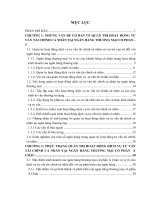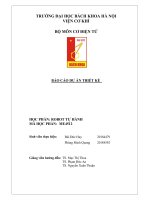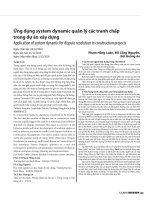Robot learning and supervisory control of a human powered
Bạn đang xem bản rút gọn của tài liệu. Xem và tải ngay bản đầy đủ của tài liệu tại đây (314.55 KB, 10 trang )
'41
UDC
việ
n
trư
ờn
g
10),
h T=
yề
nt
m
hu
to
àn
ộc
vă
t
n v rườ
ui ng
C
lò
ng ao
liê đẳ
n h ng
ệ p Cơ
hị ng
ng Th
D ị ươ
ch ng
vụ Tp
th .HC
ơn
gt M
in
-T
hư
Robot Learning and Supervisory Control of a
Human-Powered Augmentation Lower Exoskeleton
(HUALEX)
TRAN HUU TOAN
(11T-4.41Z, )
1*.
jZ15
gffs
ELI
ifft-IA*1=
(
1I-11±
eP
\11/
qu
Te.:1,1 EI
Để
xe
Bả
n
H
1117-1RJ A
P-1,---1-43YkLA UDC))
Eti -f
1ST f`J- )
ft '1173"43 71)c-
ROBOT LEARNING AND SUPERVISORY CONTROL
OF A HUMAN-POWERED AUGMENTATION
yề
nt
m
hu
to
àn
ộc
vă
t
n v rườ
ui ng
C
lị
ng ao
liê đẳ
n h ng
ệ p Cơ
hị ng
ng Th
D ị ươ
ch ng
vụ Tp
th .HC
ôn
gt M
in
-T
hư
việ
n
trư
ờn
g
LOWER EXOSKELETON (HUALEX)
A Doctoral Dissertation Submitted to
Major:
Electronic Science and Technology
Author:
Tran Huu Toan
Để
xe
Bả
n
qu
University of Electronic Science and Technology of China
Advisor:
School :
Professor Cheng Hong
School of Automation
*Ar-i•kPfi-T--Zntifc_At*At±-WIA-UT344in4JFYstii.
-
ờn
trư
Ttt.1=1,4-thAER-tiA/A'411- nwlimu., -L1/02*
việ
n
h*,
g
fFalfRf4R4RE9-MT. MVMH, Rflc_11:41-?31.1M1=WifriRiAtnith
yề
nt
m
hu
to
àn
ộc
vă
t
n v rườ
ui ng
C
lị
ng ao
liê đẳ
n h ng
ệ p Cơ
hị ng
ng Th
D ị ươ
ch ng
vụ Tp
th .HC
ôn
gt M
in
-T
hư
ts) 140.
— 1TP rh
T
TrAft:.
Fin]: 201 F 03A 30 H
*-1-4S-LikScfrt5t4-714 Tf4RA*A XNM.
A *MTjIA111*-AX-A3r19-14nfzig3see_ii6cMkrPiftfriEt,
AAjaidEltaffitt, II=AffltFP.
Để
xe
Bả
n
qu
qffifg#, UN4.4-1PLikk.
(AWAIff-v.'-V6cAfriMoitz1V--f-f-LAI)
r--
11-
L :14i A rri flP. A L 10.1 Id V IP fli.Y
g
7-1KSctl-A. -..1W.0:01-A-M.1)1M A .E"):-,:13ji4-,_,7.ifi
II
ờn
i'J5
trư
r(E*30i TOM r-11 4.4-911k
f**9-fh'i'17.VJ
T
'91' It 1) L f15 A
111‘i
"tif T
• MA!JIJ lJ ft.110.7.1131,1c'A
, .V± 7 Pi
( Fuzzy-based
Impedance
yề
nt
m
hu
to
àn
ộc
vă
t
n v rườ
ui ng
C
lị
ng ao
liê đẳ
n h ng
ệ p Cơ
hị ng
ng Th
D ị ươ
ch ng
vụ Tp
th .HC
ôn
gt M
in
-T
hư
I)
việ
n
Ve:
.ijNL 44-it 1-±I
Control strategy, FV IC ; 2)
h
j " 12_.<
- RIK ( Model-Learn i ng- based
M
Partitioned Control strategy, M L PC )
71K•Vi?, Ei-i Ifj
IttjA,IV-iilelk:NAY12.1,'J.J11=f- l'fM A ±6, 1..0.1111.13Z11'.
t-rt)537:Fil
IA kit lYjIJJt, ,N-gklEffcrellillj- 8 ,t72:'31
IMaisi,if.fi
M..1:1:112:)] .- 5. A 11 L
F [VC
rrim,131.wflYL-N: A
tk IV] I'd ftt-,1.• ffii.1
LE 7 --ft g
F I VC
.911.I 11
'1•15til4
M
- itgurn iitFvk-s-h
m
fiL
Afg
%I-
iVfl)
Id tcri IFHE
gi
11
, ,
IN*.fila A ;1917;._'±ii:i
rn-T53R. rlut, *SCA LEI TT — NI
fl-r-rtiVil)LMAMAITLIFLf:R
ff1.1 -5JriJt
IJiIMLPCO
mtM
Wfr A 1LIrJJ,i.L.411111,
313z1-d 1)=11.0.42,:gsf A VizZ_:
31.(141 WA' 733' IX I'S-ffif
A=A- K-811i r-P
;01 A 174i, fg ,/fR
5f7 tVgarg
fitfirkitha7371-191:i
tt.t*O.R41MAii).03*-41;9.111:4TitT
fit t*TiTil)-1' A fA
Để
xe
Bả
n
qu
U.1 f:g1ErIJ *-$11.TSI:
11-1
TOM- 84:. 7 -KU- IT'
Mfil'IVii1W/VE 71-17-1
: TJ13'01-141g ,
tit1IYARI gt.11.-tif:JJ
iJLriA
ABSTRACT
ABSTRACT
ờn
trư
dream in the intelligent robotic field. These wearable robots bring a numerous practical
g
Developing wearable devices for human-powered support has been a long-standing
việ
n
applications to human assistance and augmentation in daily life, yet pose many open
problems relating to anthropomorphic design and advanced control. Inspired by these
yề
nt
m
hu
to
àn
ộc
vă
t
n v rườ
ui ng
C
lò
ng ao
liê đẳ
n h ng
ệ p Cơ
hị ng
ng Th
D ị ươ
ch ng
vụ Tp
th .HC
ơn
gt M
in
-T
hư
challenges, the context of this dissertation is the emergence of powered lower
exoskeletons capable of augmenting the human muscle force and supporting
load-carrying, where exoskeletons can be worn by human-operators and need adaptive
capabilities to work in compliance with human. Two advanced control strategies have
been developed to provide the exoskeletons with the ability to be more flexible, easier
to integrate into users, and more intelligent to situational awareness. The first approach
is a newly fuzzy-based impedance control strategy proposed to provide assistive torques
by regulating the desired impedance between the exoskeleton and a wearer's lower limb
according to a specific motion speed. The effect of human behaviors on impedance
parameters changes is adopted for the fuzzy rules designed to increase the exoskeleton's
adaptation ability over a specific range of different walking speeds.
Before introducing the second control strategy, we present our investigations into
the relationship between the physical interaction torques and the dynamic factors of the
human-exoskeleton systems using state-of-the-art learning techniques. Consequently, a
novel model-learning-based partitioned control of the exoskeleton is proposed in which
the dynamics of the combined human-exoskeleton system along with the corresponding
resulting interaction torques are learned based on nonparametric regression technique
methods of the exoskeletons, this combination of incremental model learning and
partitioned control scheme can provide the robot with the ability to adapt various
dynamics of human operators, to reduce the physical interaction between the operator
Để
xe
Bả
n
qu
and then incorporated into the control system. Compared to state-of-the-art control
and exoskeleton, and to minimize the sensory system used in the system simultaneously.
As a contribution to robotic exoskeletons field, we present an original prototype of
Human-powered Augmentation Lower Exoskeleton (HUALEX) through the analysis of
human factors engineering, biomechanics, and dynamics properties. The above control
ABSTRACT
strategies are evaluated on this platform through several proposed performance indexes
as fundamental criteria in the lower exoskeleton field for hinnan augmentation. A
comparison of these strategies is discussed to present our future work. The long-term
ờn
trư
that they will be low cost, simplified and portable intelligent robots capable of
g
objective of this dissertation is to develop powered wearable lower exoskeletons such
việ
n
augmenting the human muscle force and adapting to various individuals flexibly.
yề
nt
m
hu
to
àn
ộc
vă
t
n v rườ
ui ng
C
lò
ng ao
liê đẳ
n h ng
ệ p Cơ
hị ng
ng Th
D ị ươ
ch ng
vụ Tp
th .HC
ôn
gt M
in
-T
hư
Keywords: Lower Limb Exoskeleton, Physical Human-Robot Interaction, Impedance
Để
xe
Bả
n
qu
Control, Fuzzy Logic, Model Learning, Non-parametric Regression.
Contents
Để
xe
Bả
n
qu
yề
nt
m
hu
to
àn
ộc
vă
t
n v rườ
ui ng
C
lị
ng ao
liê đẳ
n h ng
ệ p Cơ
hị ng
ng Th
D ị ươ
ch ng
vụ Tp
th .HC
ôn
gt M
in
-T
hư
ờn
việ
n
trư
ABSTRACT
II
Contents
iv
List of Figures
vu
List of TablesX
List of Abbreviations
XI
Chapter L Introduction
1.1 Motivation
1.2 Research background and dissertation approach
4
1.3 Contributions
ii
1.4 Dissertation Outline
12
Chapter 2. Theoretical Background
15
2.1 Human B io mechanics
15
2.2 Kinematics and Dynamics of Lower Exoskeleton
17
2.3 Fuzzy Logic
2.4 Supervised Learning in Robotics
23
Chapter 3. The Human-powered Augmentation Lower Exoskeleton System
26
3.1 Single DOF exoskeleton platform
26
3.2 Human-powered Augmentation Lower Exoskeleton (HUALEX)
29
3.2.1 Kinematics and mechanical design
29
3.2.2 Actuators
31
3.2.3 Sensory system
32
- 3.2.4 Networked control architecture
34
3.2.5 Interface and safety
35
Chapter 4. Fuzzy-based Impedance Regulation for Control of the Coupled
Human-Exoskeleton System
37
4.1 Introduction
37
4.2 Experimental analysis at knee joint
39
4.2.1 Model of the coupled human-exoskeleton system
39
4.2.2 Estimation of physical human-exoskeleton parameters
40
4.3 Fuzzy-based impedance regulation
42
42
4.3.1 Impedance control of the exoskeleton while interacting with human
44
4.3.2 Frequency analysis according to impedance parameters
45
4.3.3 Fuzzy-based variable impedance control
4.4 Experiments and results
48
4.5 Conclusions
51
g
Contents
IV
Để
xe
Bả
n
qu
yề
nt
m
hu
to
àn
ộc
vă
t
n v rườ
ui ng
C
lị
ng ao
liê đẳ
n h ng
ệ p Cơ
hị ng
ng Th
D ị ươ
ch ng
vụ Tp
th .HC
ôn
gt M
in
-T
hư
ờn
trư
việ
n
Chapter 5. Evaluation of a Fuzzy-based Impedance Control Strategy on a Powered
52
Lower Exoskeleton
52
5.1 Introduction
52
5.1.1 Background
54
5.1.2 Impedance control of an exoskeleton robot
5.2 Fuzzy-based variable impedance control of the coupled human-exoskeleton system
57
5.2.1 Biomechanics characteristics of human legs at different walking speeds 57
60
5.2.2 Impedance control of the exoskeleton under interacting with human
62
5.3 Fuzzy-based impedance regulation according to walking phases
63
5.3.1 Impedance regulator for swing phase
70
5.3.2 impedance regulator for stance phase
75
5.4 Experimental results and discussion
75
5.4.1 Experimental procedure
77
5.4.2 Compliance and resulting interaction
79
5.4.3 Power consumption
81
5.4.4 Load transfer through the lower exoskeleton
83
5.5 Conclusions and future work
Chapter 6. The Relationship between Physical Human- Exoskeleton Interaction
84
and Dynamic Factors: Using a Learning Approach for Control Applications
84
6.1 Introduction
86
6.2 Related work
87
6.3 Description
87
6.3.1 Model of the combined human-exoskeleton system
88
6.3.2 Representation of the interaction resulting from the human
90
6.4 Supervised learning with nonparametric regression techniques
90
6.4.1 Statistical learning of nonlinear mapping of the RPIT
90
6.4.2 Gaussian Process Regression (GPR)
91
6.4.3 Locally Weighted Projection Regression (LWPR)
93
6.5 Experimental results and analysis
93
6.5.1 Experiments without control
95
6.5.2 Experiments with a simple master-slave control
96
6.6 Control applications based on the learned models
97
6.6.1 Variable impedance control with the learned interaction model
97
6.6.2 Partitioned control with learned dynamics-interaction model
98
6.7 Conclusions and future work
Chapter 7. Learning Dynamic Model of a Lower Exoskeleton Interacting with
Human for Partitioned Control
99
99
7.1 Introduction
103
7.2 Model-learning-based partitioned control .strategy (MLPC)
g
Contents
V
Để
xe
Bả
n
qu
yề
nt
m
hu
to
àn
ộc
vă
t
n v rườ
ui ng
C
lị
ng ao
liê đẳ
n h ng
ệ p Cơ
hị ng
ng Th
D ị ươ
ch ng
vụ Tp
th .HC
ôn
gt M
in
-T
hư
ờn
việ
n
trư
104
7.2.1 Control of lower exoskeletons with model-based approach
106
7.2.2 Key features of human-robot model learning
109
7.3 Implementation on HUALEX
109
7.3.1 Analysis in Swing Phase
110
7.3.2 Control law based on learned model
Ill
7.4 Evaluation of the proposed algorithm in computer simulations
Ill
7.4.1 Simulation implementation.
114
7.4.2 Results and analysis
117
7.5 Experimental evaluation
117
7.5:1 Experimental procedure
119
7.5.2 Results and discussion
122
7.6 Discussion and Conclusion
124
Chapter 8. Conclusions and Future Work
124
8.1 Summary of the dissertation
126
8.2 Comparison of FVIC and MLPC
129
8.3 Future work
129
8.3.1 Hardware improvement
130
8.3.2 Learning impedance control
8.3.3 Motion modes and transitions recognition of a hybrid human-exoskeleton
131
agent
135
Acknowledgements
136
References
146
Research Results Obtained During the Study for PhD Degree
APPENDIX A Control loop flowchart of fuzy-based variable impedance control
147
developed for HUALEX
Control loop flowchart of online model-learning based partitioned
APPENDIX B
148
control simulated for HUALEX
g
Contents
List of Figures
List of Figures
Figure 1-1 Different types of wearable exoskeletons:
Figure 2-1 Sign convention determined for joint angles in the sagittal plane
15
Figure 2-2 Walking gait characteristics 1641
16
việ
n
yề
nt
m
hu
to
àn
ộc
vă
t
n v rườ
ui ng
C
lò
ng ao
liê đẳ
n h ng
ệ p Cơ
hị ng
ng Th
D ị ươ
ch ng
vụ Tp
th .HC
ôn
gt M
in
-T
hư
Figure 2-3 Full 5-DOF lower limb exoskeleton model in the sagittal plane
18
Figure 2-4 2-DOF swing leg model
20
Figure 2-5 Fuzzy systems structure
22
Figure 2-6 Typical examples of membership function
23
Figure 2-7 Approaches to robot learning [71
.74
Figure 3-1 Experimental platform and interface for single DOE' exoskeleton
26
Figure 3-2 Diagram of the 1-DOF lower exoskeleton's assembly in . UESTC
97
Figure 3-3 Diagram of distributed embedded system for single DOF platform
28
Figure 3-4 Human-powered Augmentation Lower Exoskeleton (HUALEX)
29
Figure 3-5 Designed HUALEX in Solidworks
30
Figure 3-6 Inclinometer and sensor-integrated foot
32
Figure 3-7 Custom-built force sensors for measuring the resulting interaction force from
human on the exoskeleton at thigh and shank connections
33
Figure 3-8 Networked control architecture
34
Figure 4- l Single DOF platform and impedance model
40
Figure 4-2 One of the trials for parameter estimation of lower thigh of
human-exoskeleton system
42
Figure 4-4 Frequency analysis of the impedance controlled human-robot system
44
Figure 4-5 Membership functions for the inputs Ob (a) and 0 (b)
46
Figure 4-6 Membership function for the output D
47
Để
xe
Bả
n
qu
Figure 4-3 Principle of the frizzy-based regulated impedance control for the lower
exoskeleton interacting with human
44
Figure 4-7 Characteristic surface of fuzzy-regulated viscous coefficient
48
Figure 4-8 Comparison of control performances of TIC (left) with FVIC (right)
49
Figure 5-1 Control of motion and human-robot interaction for lower exoskeletons
55
Figure 5-2 The resulting interaction forces Fhl; Flo from hip .and knee torques at the
vu
ờn
13
trư
Figure 1-2 The dissertation organization
g
8


